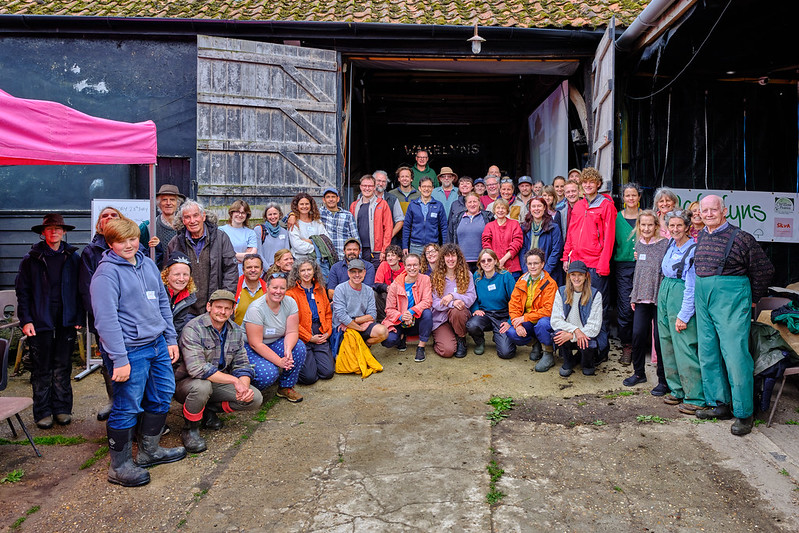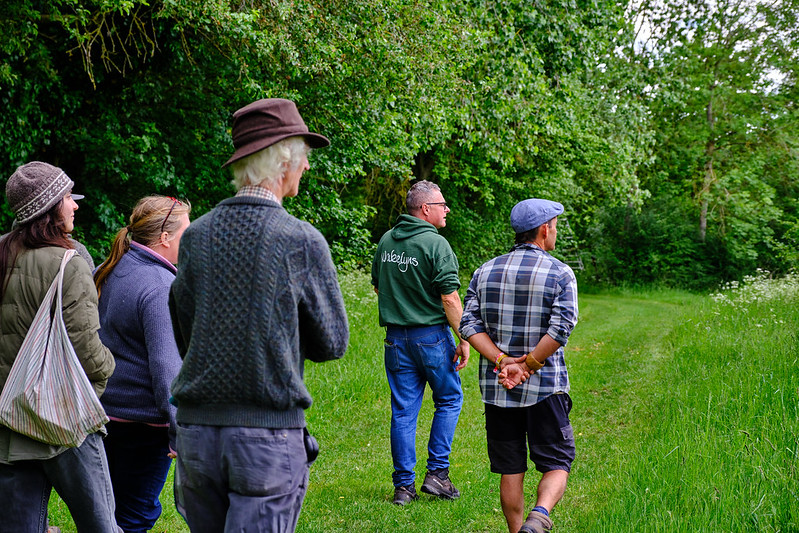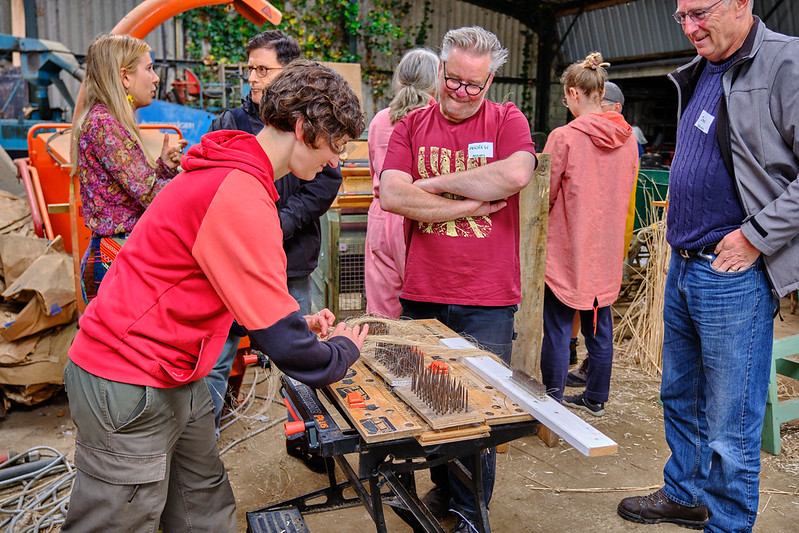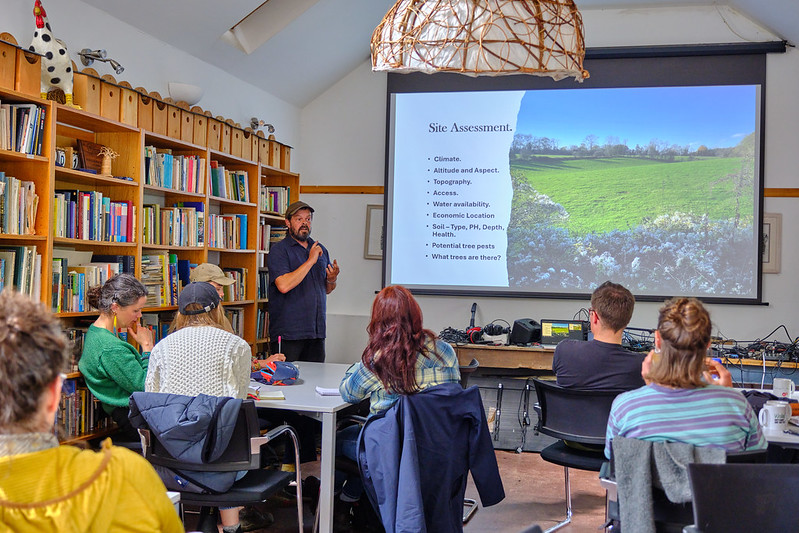
Last week, surrounded by the willows and hazel, alder and oak, medlars, cherries, and apples of the pioneering agroforestry farm Wakelyns, we came together to explore all things agroforestry for our second In the Field event of 2025.
We gathered for three packed days of learning, sharing, and connection through hands-on workshops, inspiring talks, tours, and community-building around the campfire. From practical skills like hemp processing and soil science to wider conversations about agroforestry beyond the Wakelyns model, the event brought together farmers, researchers, craftspeople, and landworkers from across the UK.
Exploring the Farm and Its History
First bought in 1992, and with the first trees planted in 1994, Wakelyns is one of the oldest and most diverse agroforestry farms in the country. Today, it exemplifies how agroforestry can be both ecologically and economically successful.
Trees play a central role on the farm, providing sticks (the most lucrative crop) as well as wood chips for fuel. The farm features a diverse mix of fruit and timber trees, and the layout has been designed to accommodate machinery. The cropping system includes wheat, lentils, hemp, and fertility leys, with different elements such as accommodation pods integrated directly into the farming rotation. This doesn’t mean turning farming land into glamping, rather, it means integrating pods into the farming system.
The farm exemplifies the power of short food chains and value-added processing. Rather than selling raw produce, food is processed into products like juice, chutney, jam, bread, and pasta to retain more value on the farm. Enterprises like Silva Bakery, an apple juice operation, basket weaving, and textile dyeing are all part of the farm’s web of interconnected businesses. Though independently run, these businesses collaborate closely and are marketed and branded together.

Beyond enterprise building, 30 years of working with nature have yielded incredible ecological results. The Waterfield, once prone to flooding, is now managed by mature trees that regulate water year-round, and restored ponds and thriving birdlife, including turtle doves, hobbies, and chiffchaffs, showcase the farm’s remarkable ecology.
Wakelyns and its enterprises continue to evolve and adapt into the future. For example, David’s new grapevines will explore how red grape varieties fare with the changing climate.
Delving into the Workshops and Talks
Claire and Kitty run Contemporary Hempery onsite at Wakelyns, which explores traditional hemp growing and processing for fine textiles. As part of their workshop, we processed the hemp for its fibre – breaking, scutching and heckling the stems, and later weaving a communal cloth with the fibre we produced. Claire and Kitty are now organising a natural textiles festival with three days of harvesting, workshops, music, dance, which brings people from all over the world.
Hemp farming has a rich history in the UK, and Kitty and Claire explained to us how in the past, different families specialised in various stages of hemp processing. Nowadays, while Contemporary Hemporary are licensed to use the fibres, the legal status of hemp means all other parts of the plant must be composted.

For their workshop exploring tree fodder, or ‘the forgotten feed’, Lindsay and Matt from Organic Research Centre and Agricology discussed the role of natural nutritional wisdom in silvopasture systems, where animals use trees as a source of food and medicine. They highlighted how browsing behaviour changes with seasons and stress, and how modern farming practices, like separating calves from their mothers, can disrupt animals’ ability to learn what and how to eat.
Between workshops, Andrew Neal from Rothamsted Research spoke in-depth on the effects of agroforestry on soil health. He explained how intensive agriculture has stripped soils of carbon, leaving them less porous, less connected, and less resilient. In contrast, soils rich in organic matter and carbon, such as agroforestry systems, hold water better, support vibrant microbial life, and cope far more effectively with extreme weather.
We were lucky to have Andy Dibben, ORFC Farm Practice advisor and Head Grower at Abbey Home Farm, also on site. Through Andy’s workshop, we learned about some of the possibilities for agroforestry beyond the Wakelyns model, for example, by using trees as windbreakers and natural pest control, as Andy does at Abbey Home. Andy shared with us deep, practical knowledge on how to build, maintain, and help agroforestry systems to evolve.
Alongside incredible discussions on agroforestry grants with Kinna Mosley, engaging talks on growing peas in trees with Josiah from Hodmedods, and guided bird watching with Harry Read, we couldn’t have asked for a more enriching and exciting few days.

Final Thoughts
As one attendee told us, and as is often the case at such events, speaking with the friendly faces of other participants around you is often just as interesting as hearing what the tutors and speakers have to say. With participants from such a wide range of ages and backgrounds from across the UK, conversations continually buzzed over tea breaks, shared meals, and evening campfires throughout the gathering.
We are hotly anticipating our final In the Field event of 2025, where we’ll be showcasing regional livestock farming excellence in the Yorkshire Dales at Hill Top Farm for an incredible two days of practical workshops, talks, and knowledge sharing, on July 23-24.


